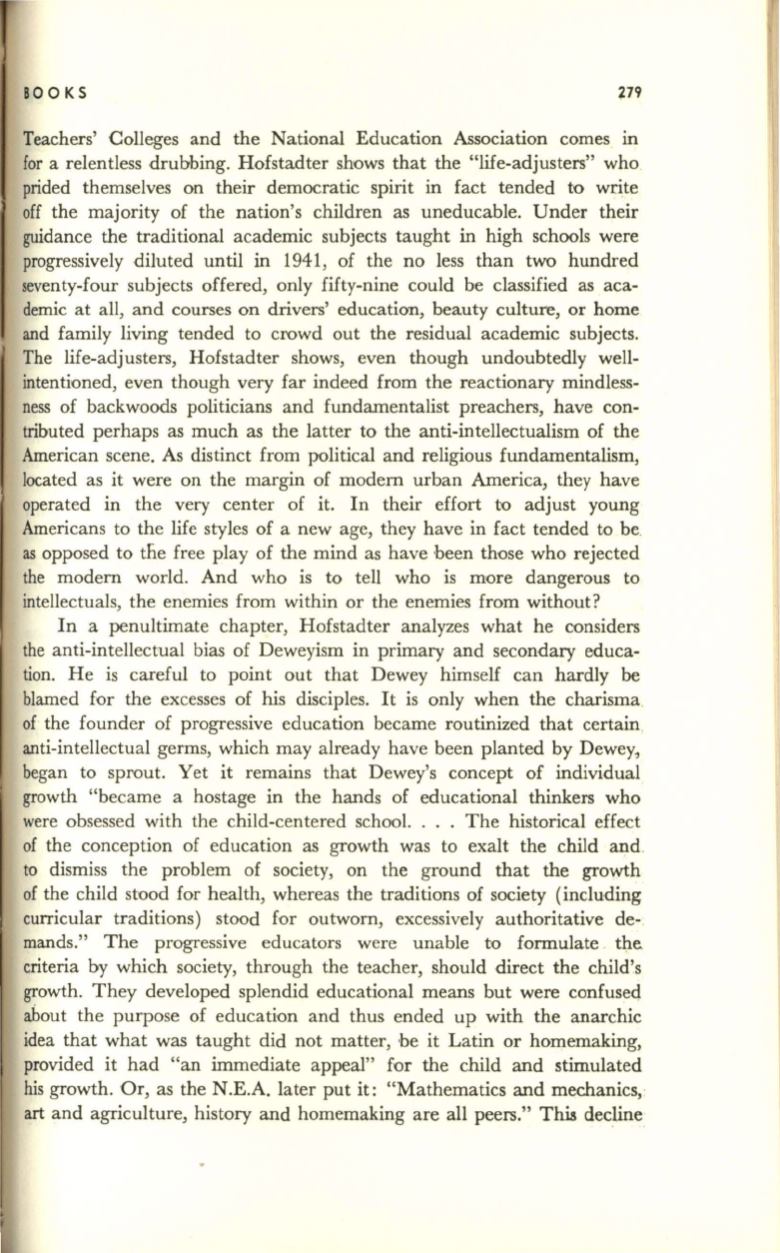
BOO KS
279
Teachers' Colleges and the National Education Association comes in
for a relentless drubbing. Hofstadter shows that the "life-adjusters" who
prided themselves on their democratic spirit in fact tended to write
off
the majority of the nation's children as uneducable. Under their
guidance the traditional academic subjects taught in high schools were
progressively diluted until in 1941, of the no less than two hundred
seventy-four subjects offered, only fifty-nine could be classified as aca–
demic at all, and courses on drivers' education, beauty culture, or home
and family living tended to crowd out the residual academic subjects.
The life-adjusters, Hofstadter shows, even though undoubtedly well–
intentioned, even though very far indeed from the reactionary mindless–
ness of backwoods politicians and fundamentalist preachers, have con–
tributed perhaps as much as the latter to the anti-intellectualism of the
American scene. As distinct from political and religious fundamentalism,
located as it were on the margin of modem urban America, they have
operated in the very center of it. In their effort to adjust young
Americans to the life styles of a new age, they have in fact tended to be.
as
opposed to tne free play of the mind as have been those who rejected
the modem world. And who is
to
tell who is more dangerous to
intellectuals, the enemies from within or the enemies from without?
In a penultimate chapter, Hofstadter analyzes what he considers
the anti-intellectual bias of Deweyism in primary and secondary educa–
tion. He is careful to point out that Dewey himself can hardly
be
blamed for the excesses of his disciples.
It
is only when the charisma.
of the founder of progressive education became routinized that certain,
anti-intellectual germs, which may already have been planted by Dewey,
began to sprout. Yet it remains that Dewey's concept of individual
growth "became a hostage in the hands of educational thinkers who
were obsessed with the child-centered school. ... The historical effect
of the conception of education as growth was to exalt the child and.
tv
dismiss the problem of society, on the ground that the growth
of the child stood for health, whereas the traditions of society (including
curricular traditions) stood for outworn, excessively authoritative de–
mands." The progressive educators were unable
to
formulate the.
criteria
by
which society, through the teacher, should direct the child's
growth. They developed splendid educational means but were confuseq
about the purpose of education and thus ended up with the anarchic
idea that what was taught did not matter, be it Latin or homemaking,
provided it had "an immediate appeal" for the child and stimulated
his growth. 'Or, as the N.E.A. later put it: "Mathematics and mechanics,
art
and agriculture, history and homemaking are all peers." This decline


